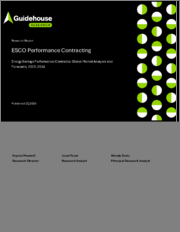
|
시장보고서
상품코드
1734249
ESCO 보증 계약ESCO Performance Contracting: Energy Savings Performance Contracts - Global Market Analysis and Forecasts, 2025-2034 |
||||||
에너지 서비스 기업(ESCO)이 제공하는 에너지 절약 보증 계약(ESPC)은 많은 고객 부문에서 비용 절감, 에너지 효율성 및 인프라 복원력을 향상시킬 수 있으며, 연방 및 지방 정부 건물, 병원, 교육 시설에 직접적으로 혜택을 줄 수 있습니다. 이익을 가져다 줄 수 있습니다. 다른 수혜자로는 민간 상업 및 산업 건물, 유틸리티, 군사 기관 등이 있습니다.
세계적으로 ESCO의 사용은 여러 시장 성장 촉진요인에 의해 뒷받침되고 있습니다. 공공 기관과 민간 기업 모두 비용 절감, 인프라 업그레이드, 에너지 효율 및 복원력 향상에 대한 ESPC의 매력에 매료되어 있으며, ESPC 활용을 촉진하는 다른 주요 요인으로는 기업의 탈탄소화 목표, 법률 제정, 건축 성능 기준, 유틸리티 기반 프로그램, 에너지 시장 진입 인센티브, 잉여 자본을 보유한 기업 등이 있습니다. 그러나 이러한 성장에도 불구하고 ESCO 보증 계약 시장은 주목할 만한 장벽에 직면해 있습니다. 지속 가능한 성장은 이해관계자들이 ESCO 보증 계약의 이점에 대한 인식을 제고함으로써 이러한 문제를 해결할 수 있느냐에 달려있습니다.
본 보고서는 ESCO 보증 계약 시장을 조사했으며, 초중등교육, 주/지방정부, 연방/중앙정부, 고등교육, 의료/병원, 상공업의 6개 고객 부문별 ESCO 보증 계약의 주요 동향을 분석하였습니다. 또한, ESPC에서 활용되고 있는 고객의 에너지 효율성, 비용 절감, 인프라 가치 향상을 지원하는 6가지 기술에 대해서도 다루고 있습니다.
목차
제1장 주요 요약
- 서론
- 범위
- 시장 성장 촉진요인
- 시장 장벽
- 세계 시장 전망
제2장 시장 문제
- ESCO의 정의
- ESCO의 보증 계약 구조
- 에너지 효율 보증
- 에너지 효율 공유
- 시장의 정의
- 기술
- 고객 부문
- 성장 촉진요인
- 장벽
제3장 산업 밸류체인
- ESCO 보증 계약 밸류체인
- 경쟁 구도
- 인수합병(M&A)
- ESPC vs. 기타 계약 방법
제4장 시장 예측
- 세계 개요
- 북미
- 유럽
- 아시아태평양
제5장 결론 및 제안
- 요약
- 3대 포인트
- 제안
- ESCO
- 정부
제6장 두자어 및 약어 리스트
제7장 목차
제8장 도표
제9장 조사 범위, 정보원, 조사 방법, 주석
LSH 25.06.10The energy savings performance contracts (ESPCs) offered by energy service companies (ESCOs) can increase cost savings, energy efficiency, and infrastructure resilience across numerous customer segments. ESPCs can directly benefit federal and municipal government buildings, hospitals, and education facilities. Other beneficiaries include private commercial and industrial (C&I) buildings, utilities, and military institutions.
Multiple market drivers support the use of ESPCs globally. Both public and private entities are attracted to the cost savings, infrastructure upgrades, and increased energy efficiency and resilience that result from ESPCs. Other key drivers of ESPC use are corporate decarbonization goals, enabling legislation, building performance standards, utility-based programs, energy market participation incentives, and companies with excess capital. Yet despite noticeable growth, the ESCO performance contracting market faces noteworthy barriers. Continued growth will depend on stakeholders addressing challenges by increasing awareness of the benefits of using ESPCs as a contracting mechanism.
This Guidehouse Insights report analyzes major trends in ESCO performance contracting across six customer segments: primary and secondary education, state and local government, federal or national government, higher education, healthcare and hospitals, and C&I. It covers six technologies utilized in ESPCs that help customers increase energy efficiency, cost savings, and infrastructure value: HVAC, lighting, building controls, water efficiency, onsite supply and renewables, and EV charging. The report provides an overview of the drivers and barriers for the ESCO performance contracting market and offers recommendations for ESPC stakeholders. Finally, it projects global revenue from ESPCs by region, customer segment, and equipment type from 2025 through 2034.
Table of Contents
1. Executive Summary
- 1.1 Introduction
- 1.1.1 Scope
- 1.1.2 Market Drivers
- 1.1.3 Market Barriers
- 1.2 Global Market Outlook
2. Market Issues
- 2.1 ESCOs Defined
- 2.2 ESCO Performance Contracting Mechanisms
- 2.2.1 Guaranteed Savings
- 2.2.2 Shared Savings
- 2.3 Market Definitions
- 2.3.1 Technologies
- 2.3.2 Customer Segments
- 2.4 Drivers
- 2.4.1 Cost Savings and Aging Infrastructure
- 2.4.2 Resilience and Energy Efficiency Benefits and Sustainability Commitments
- 2.4.3 Enabling Legislation, Building Performance Standards, and Utility-Based Programs
- 2.4.4 Demand Response and Net Metering Incentives
- 2.4.5 Companies with Excess Capital
- 2.5 Barriers
- 2.5.1 Political Uncertainty
- 2.5.2 Talent Gap
- 2.5.3 Availability of Capital and Long-Term ROI
- 2.5.4 Low Energy Prices
- 2.5.5 Diminishing Opportunities to Increase Energy Efficiency
3. Industry Value Chain
- 3.1 ESCO Performance Contracting Value Chain
- 3.2 Competitive Landscape
- 3.2.1 Mergers & Acquisitions
- 3.2.2 ESPCs vs. Other Contracting Mechanisms
4. Market Forecasts
- 4.1 Global Overview
- 4.2 North America
- 4.3 Europe
- 4.4 Asia-Pacific
5. Conclusions and Recommendations
- 5.1 Summary
- 5.2 Three Big Takeaways
- 5.3 Recommendations
- 5.3.1 ESCOs
- 5.3.2 Governments



















